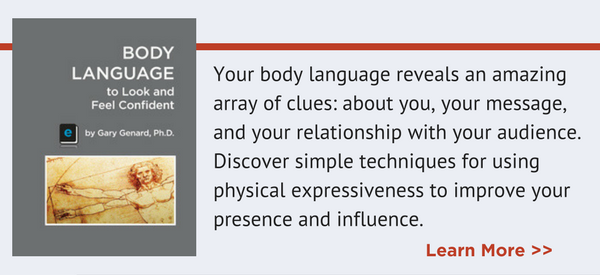
Negative body language in public speaking hurts your credibility. Read this to see if you're guilty of the ‘7 deadly sins’ of nonverbal communication.
Body language is fascinating, isn't it? We're all intensely interested in knowing what another person's gestures, facial expressions, and postures mean. You don't have to be a body language expert to find yourself asking these questions:
What does that gesture signify?
Is he or she responding positively to me?
Am I seeing truthfulness or lying?
Is any of this nonverbal behavior reliable information?
Discover how to boost your impact and persuasiveness! Download my free guide, "The Body Language Rules: 12 Ways to Be a More Powerful Speaker."
Body Language Is Key to Nonverbal Communication
If you're that interested in what other people reveal in terms of their intensions and motives, think about that from the opposite direction. What about when you're the one interacting with others, especially in a speech or presentation? Naturally, your audience wants to know these things about you:
- Are you trustworthy?
- Is what you're saying credible?
- Do you have the audience's interests at heart rather than your own?
- Are you a confident speaker?
- Can they believe in your message?
The list is actually much longer. What it all comes down to is how you're coming across to that audience, and whether your message is resonating. Clearly, you need to use body language powerfully to be credible and persuasive in the eyes of your audience. It's a central part of my free guide, 6 Rules of Effective Public Speaking.

The 7 Deadly Sins of Nonverbal Communication
Remember: audiences will make decisions about you based in large part on what you're showing them. That includes what I call "negative body language." Broadcasting any of these "cardinal sins" is guaranteed to undermine your credibility and influence.
If you see your own behavior flagged in any of the "7 Deadly Sins of Nonverbal Communication" below, it's time to take stock. Learn more about how to be an effective business speaker—which includes using body language that helps rather than hurts your cause!
#1. Poor stance or posture.
Audiences cue in on your sense of self-worth based in part on how you hold yourself. Slumped shoulders and a caved-in chest indicate surrender, not a willingness to take on the world. One of my mantras at The Genard Method when I'm working with a client on body language is: "How you stand affects your standing with the audience." Here's an easy yet effective exercise: Imagine a string leading from the top of your head into infinity. Someone is tugging gently and steadily on that string. Allow yourself to respond, while you stand in front of a mirror. Notice how much more capable and confident you look when you straighten up?
#2. Avoiding eye contact.
You know the variations of this one. There's the nervous speaker who talks to the floor; or the PowerPoint user who has a cozy dialogue with the screen while ignoring the audience. How about the keynote speaker who has an excellent relationship with his or her notes rather than the people in the seats? Trust is your most valuable commodity as a speaker—an attribute that begins and ends with eye contact. To dramatically improve your eye contact in public speaking, use this technique.
#3. Creating a barrier that shuts out listeners.
This sin has many variations. Standing with arms crossed. The fig leaf position with the hands 'protecting' the crotch. Creating a church steeple with one's fingers. "Washing" one's hands while speaking. With every one of these practices, the speaker is creating a physical barrier between her or him and listeners. To avoid them, simply start with your arms at your sides, and bring them up to make a gesture when you need to. That will really amplify what you're saying.
#4. Unproductive use of space.
Believe it or not, it's easy to over-emphasize gestures and ignore using space! Public speaking audiences expect a performer, not a statue. In fact, it's your job to know how to use body language to command space. Using different parts of the stage tells an audience you're comfortable up there. If you stand in a different spot for each of your main points, listeners will retain each one of them better. Here are 5 acting techniques to improve your stage presence in public speaking.
#5. Employing weak or repetitive gestures.
"What should I do with my hands?" is a frequent question of anxious speakers. The answer is simple: gestures should be essential to what you're saying. As Hamlet put it, "Suit the action to the word, the word to the action." If you keep that thought in mind, it should actually become difficult to use too many gestures, since any one gesture couldn't possibly fit that many expressions! The other half of this equation is the power and spareness of the gesture. Each one should be strong, clearly support the phrase or idea, and end cleanly. Want to know more? Here's how to use gestures to be a strong speaker.
#6. Relating negatively to listeners.
You've seen speakers accomplish this remarkable feat: Rather than cultivating influence with an audience, they antagonize them. Negative facial expressions; nodding impatiently at a questioner so they'll shut up so you can answer; pointing a stiff finger at the next unlucky questioner. Even looking at the floor as you ponder your momentous reply—these behaviors seem to say, "I'm really not enjoying having this dialogue with you." Pretty soon, of course, the audience will feel the same way.
#7. Clumsy use of objects.
You've seen plenty of examples of this one: the whiteboard or flip chart marker held but never used; the piece of chalk tossed into the air during a lecture; or the microphone held in a gesturing hand. There's even a dangerous version: laser pointers whose beams dance across audience members' faces! Like actors with props, speakers need to use objects rather than being used by them. As a minimum exercise in mastering objects, come out from behind a lectern whenever possible. A lectern is the worst item of all because it's a physical barrier between you and the audience. For that reason, I call it one of the "Devil's Tools."
This blog was first published in 2017. It is updated here.
You should follow me on Twitter here.



